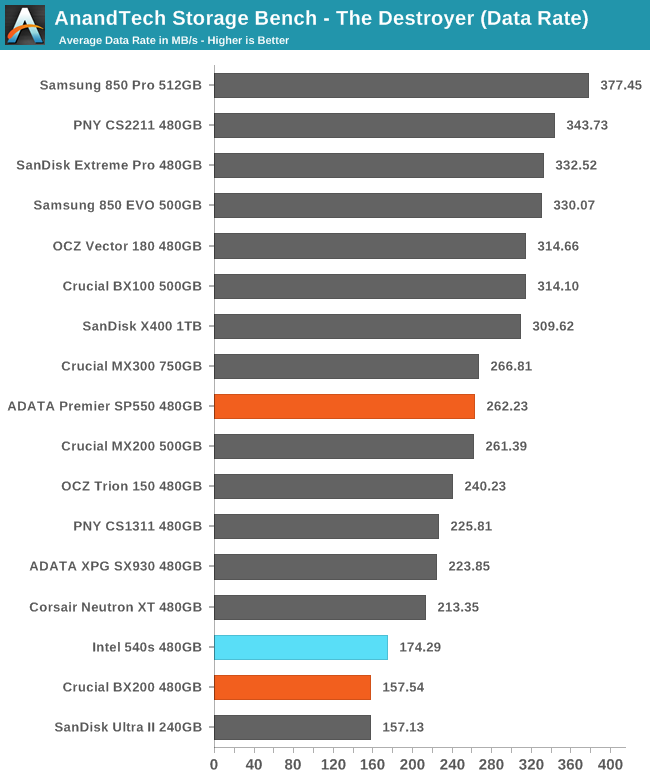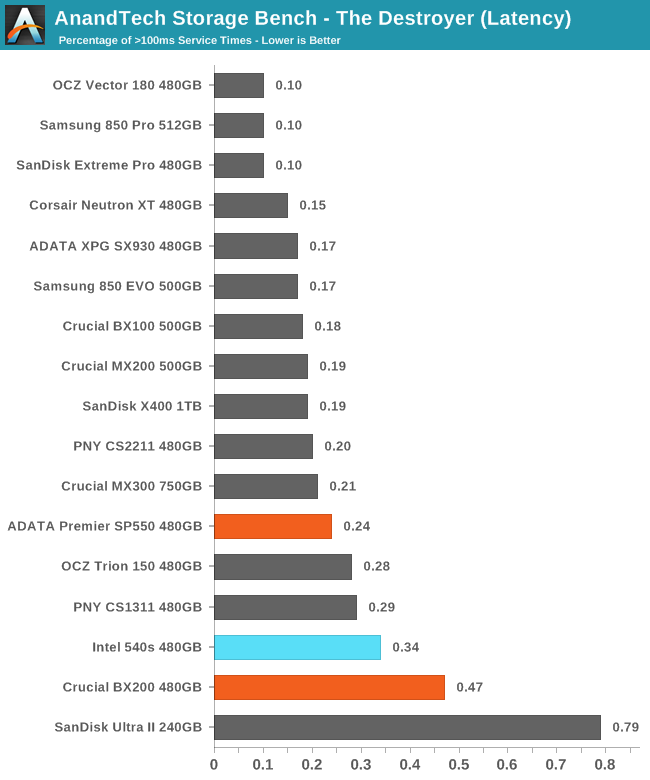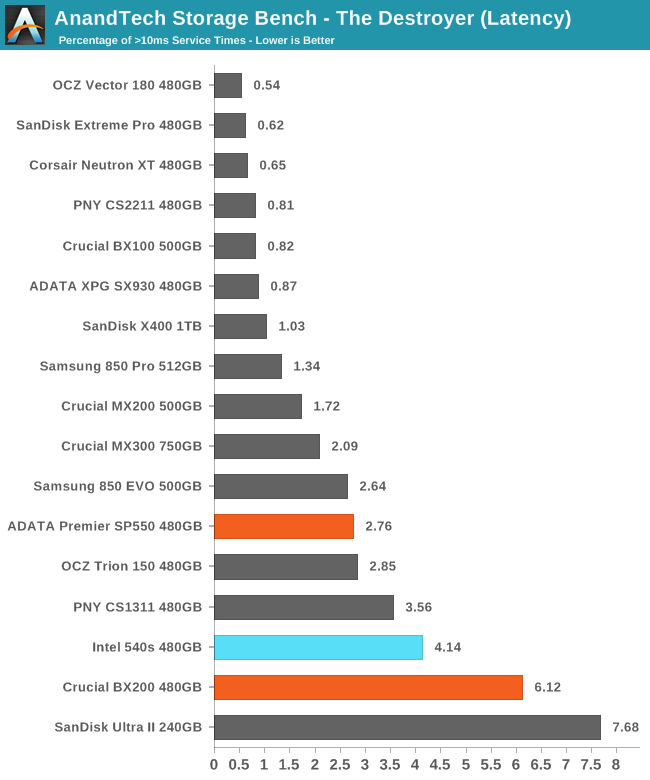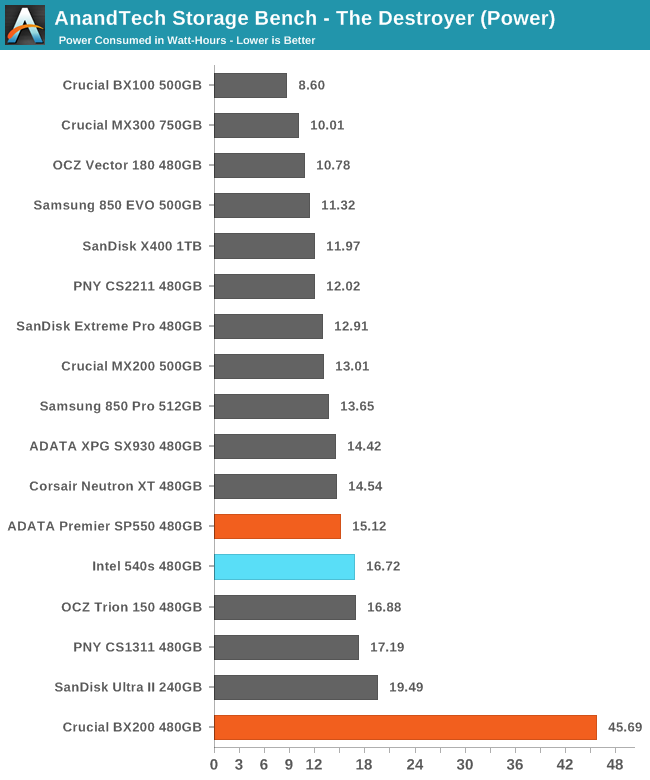The Intel SSD 540s (480GB) Review
by Billy Tallis on June 23, 2016 9:00 AM ESTAnandTech Storage Bench - The Destroyer
The Destroyer is an extremely long test replicating the access patterns of very IO-intensive desktop usage. A detailed breakdown can be found in this article. Like real-world usage and unlike our Iometer tests, the drives do get the occasional break that allows for some background garbage collection and flushing caches, but those idle times are limited to 25ms so that it doesn't take all week to run the test.
We quantify performance on this test by reporting the drive's average data throughput, a few data points about its latency, and the total energy used by the drive over the course of the test.

On The Destroyer, the ADATA SP550 was able to punch above its weight and perform on par with planar TLC drives of twice the capacity, while the Crucial BX200 performed below expectations. The Intel 540s unfortunately demonstrates more of the latter, with an average data rate that is not as bad as the BX200 but is still clearly outclassed by the Phison S10 TLC drives and the SP550.

As with the average data rate, the average service time of the 540s is poor but not quite as bad as the BX200. The SP550 didn't rank much higher on this metric, but in absolute terms it was significantly faster.


The frequency of latency outliers shows similar rankings, with the Intel 540s near the bottom of the chart and between the two SM2256 drives.

Power efficiency has regressed slightly compared to the SP550, but the Intel 540s clearly doesn't have anything horribly wrong going on the way the BX200 did.










77 Comments
View All Comments
doggface - Thursday, June 23, 2016 - link
I am ... Amazed that Intel would dirty their brand name like this. Truly a terrible controller, terrible flash, and a terrible idea.Intel has a brand name that generally speaks to quality parts. They should never have dabbled in the arena of TLC.
ddriver - Thursday, June 23, 2016 - link
Reveals optane, releases mediocrity... come on.Drumsticks - Thursday, June 23, 2016 - link
I actually worked on this for a short time last year, and I can say - working with SMI definitely is not as easy (at least for Intel) and was certainly more frustrating than developing in house.BurntMyBacon - Friday, June 24, 2016 - link
Any reason they didn't label a drive with this level of performance a 300 series drive?Drumsticks - Friday, June 24, 2016 - link
No idea, honestly. I think everything is just a 5xx SSD now (at least the SATA stuff). I think it's priced well above what I was expecting it to be priced at though, tbh.pwil - Wednesday, July 27, 2016 - link
300 series had 3y warranty.JoeyJoJo123 - Thursday, June 23, 2016 - link
HERE COMES THE SSD MEMES!>Muh MLC!
>Muh endurance!
>Muh data retention!
>Muh reliability!
>Muh random I/O!
>Muh this drive isn't exactly what I want in my PC, so instead of using PC Part Picker to find a suitable drive for my incredibly critical tastes, I'm going to post a comment on a news article expressing how disgusted I am by how this drive isn't up to _MY_ standards.
FUN FACT: Did you know that companies design products for people besides yourself?
b4bblefish - Thursday, June 23, 2016 - link
Meh... it's not that they make products for people besides us. It's that for the price it's a horrible deal. You can buy better more reliable drives for a lot cheaper especially if it's targeting the entry level consumer market. So why bother entering this segment and offer something without any value?JoeyJoJo123 - Thursday, June 23, 2016 - link
Because these drives are likely aimed at bulk government/corporate purchases, not really for consumers as the price/performance ratio is terrible. Government/corporate entities will end up buying bulk, even when the price isn't the best available, from what the business analysts approve as reputable companies; not because it's a wise purchase from an IT perspective.I guarantee you this: It's got an Intel sticker, so it'll be bought in droves by people who don't know, even if it sucks. See: Pentium 4.
And secondly, nobody should ever care for brand image. Every brand releases crap products from time to time. Some brands do this more often than others. Always evaluate products on an individual level, not because they happen to come from some "reputable" brand.
techconc - Thursday, June 23, 2016 - link
I agree with most of your post. However, you went off the rails with regard to brand image. Yes, you shouldn't buy based on brand image alone. However, all things being equal, brand reputation does come into play. Companies earn a reputation, for better or worse, based on the quality of the product they produce. Completely disregarding that history isn't very good advice.